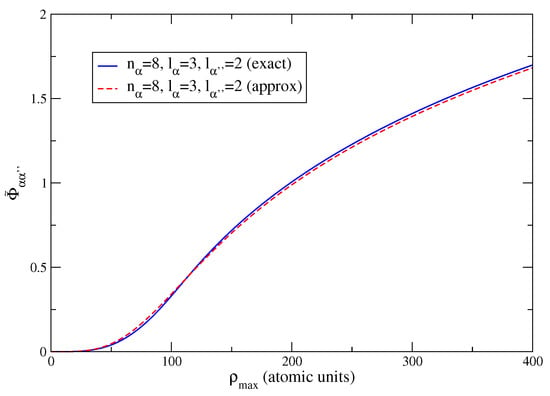Abstract
The expression of the electron broadening operator including the effect of penetrating collisions, i.e., for which the incoming electron enters the extent of bound-electron wave-functions, is rather complicated, even for hydrogen. It involves integrals of special functions, the evaluation of which deserves scrutiny. We present a simple approximate form of the electron collision operator for hydrogen including penetration effects, both in direct and interference terms. The new expression is accurate and easy to compute. In the Penetration Standard Theory, the collision operator is convergent whatever the value of the maximum impact parameter. However, when penetration theory is not valid anymore, it should be questioned. We discuss the problem of strong collisions when penetration effects are taken into account.
1. Introduction
Line-shape profiles are important ingredients of opacity and emissivity calculations, as they often serve as a diagnostics of laboratory or astrophysical plasmas. Indeed, the profiles contain information about local electric fields produced by electron and ion perturbers, leading to Stark splitting, and about density and temperature of the plasma. High-mobility electrons perturb the emitter by collisions, possibly causing the interruption of the spontaneous emission and altering the emitter energy levels [1].
The problem of spectral line broadening due to emitter–perturber interactions has been largely studied. It started early with the works of Baranger [2], Kolb and Griem [3], and Anderson’s theory [4]. During the last decades, the quantum-statistical approach has been introduced to determine the shift and the width of spectral line shapes [5,6]. It is based on Green’s function technique in which the line profiles are described by the two-particle polarization function related to the dipole-dipole correlation function. Besides the theoretical approaches, the computer-simulation methods based on the molecular-dynamics approach, have been successfully applied to calculate the spectral line shapes [7]. In these computations, which are very efficient but expensive, the time-evolution operator for the simple model of the plasma is obtained by solving numerically the time-dependent Schrödinger equation accounting for the many-body interactions between the emitter and the surrounding moving particles. Then, the spectral profile is obtained by averaging over a large number of plasma configurations [8]. A few years ago, Bedida et al. [9] applied the path-integral formulation [10] to find the expression of the dipolar auto-correlation function in order to study the spectral line shapes in plasmas.
In the so-called “standard line shape theory” (ST: Standard Theory), electrons are modeled in a binary-collision theory, using classical-path trajectory and often second-order perturbative treatment of electron broadening operator (Dyson series) [11,12,13,14]. Ions are described in the quasi-static approximation. For both electrons and ions, the emitter–perturber interaction is often assumed to be dipolar only. It is permissible to separate the contributions of different frequency components into a fast and a slow component (as commonly done for electrons and ions) and convolve the resulting profile, as long as the fast component satisfy the impact approximation [15]. An issue in the standard electron treatment concerns the so-called strong collisions, i.e., collisions associated to small impact parameters (or small electron velocities), for which perturbation theory is not valid and the dipole interaction is questionable due to penetration by the perturbing electrons into the atomic (bound-state) wave-function extent. A few years ago, it was suggested [16,17,18,19,20,21,22,23] that penetration was likely to be more important than thought because the standard cutoff (n is the principal quantum number and Z the atomic number) representing the wave-function extent in atomic units was too optimistic. When the spatial extent of the radiating states is comparable to the shielding length, or in other words when the important collisions with plasma electrons occur at distances within the extent of the wave-functions of the levels involved in the line emission, collisions cannot be properly treated by the usual dipole, long-range approximation, which “softens” the interaction and reduces the widths [24,25]. A consequence of this softening of the interaction is that perturbation theory may remain valid, even for some collisions previously considered as strong [18]. In the Penetration Standard Theory, the collision operator is convergent whatever the value of the maximum impact parameter. However, the validity of penetration theory should be questioned as well. The problem of strong collisions when penetration effects are taken into account deserves scrutiny.
In the present work, we propose an approximate expression of the collision operator taking penetration effects into account. The study is restricted to the hydrogen atom, i.e., straight-path trajectories. Even for hydrogen, the expression of the electron broadening operator including penetration effects is a difficult task. The formalism proposed by Alexiou and Poquérusse [18] involves particular functions that the authors obtain from recurrence relations, initialized with Bessel and Bickley–Naylor functions. We found an exact expression of such functions, which enabled us to derive a simple approximate form of the electron collision operator for hydrogen including penetration effects, both in direct and interference terms. The new expression is accurate and easy to compute. In Section 2, the expression of the collision operator is recalled, and the factor representing the penetration effects is introduced. In Section 3, our new expression of the collision operator is presented and its applicability in the velocity-impact parameter domain is studied in Section 4. Section 5 is the conclusion.
2. The Collision Operator
2.1. General Form
Throughout the paper, we set: (atomic units) and . In the standard theory, the matrix elements of the electron collision operator read
where and are upper level states, is a state perturbing the upper level states, and are matrix elements of the position operator. is a tetradic (quadruply indexed) operator, acting on initial subspace a characterized by quantum numbers of states and (i.e., ) and on final subspace b characterized by quantum numbers of states and (i.e., ). Spin quantum numbers are disregarded in the following. is the interference term and (and ) are velocity integrated complex functions of standard theory. More precisely, one has, choosing explicitly a straight-line trajectory :
where
More than thirty years ago, a discussion took place about the physical meaning of the so-called interference term [26,27,28,29,30]. That term does not account for any physical requirement: it results from a mathematical expansion in power series. It is a consequence of the fact that the states of the upper and lower groups feel the same perturbing field. This keeps coherence in the evolution of those states and reduces the broadening effect due to the collisions.
A collision with a plasma electron has a non-negligible probability amplitude to cause a transition . and are lower level states and perturbs them. The no-quenching approximation consists in assuming that have the upper-level principal quantum number and have the lower-level principal quantum number . In the present work, transitions due to collisions between the states of the upper group and the states of the lower group have not been taken into account. We use the notations
and
where is the position of the electron with respect to the center of the atom in cartesian coordinates. One has
and
One has also
The general formula for dipole () radial integrals of one-electron systems has been obtained by Gordon in terms of hypergeometric functions [31,32,33]. For , one has1:
where , and . The Gauss hypergeometric function is:
In the case , the formula is simpler:
2.2. Collision Integral
The impact approximation is valid when [11,12]:
- The duration of a collision is small compared to the mean time between collisions. In that case, radiation can be neglected during the collision, which can be considered as instantaneous.
- The duration of a collision is much smaller than the inverse HWHM (half width at half maximum) of the profile .
- The collisions are complete, which means that they can be considered as instantaneous in comparison with . Therefore, the radiation process of the emitter can be decoupled from the interaction process with perturbers.
In fact, an impact theory with a complete-collision assumption can be used only for values of smaller than the electron plasma frequency. It was shown that the complete-collision assumption may be corrected in the line wings by means of the Lewis cutoff [34]. The so-called relaxation theory [35] does not make such an assumption, and is in good agreement with the impact theory corrected by the Lewis cutoff.
In the classical picture, the electrons are assumed to follow straight paths for the hydrogen [36] and neutral helium lines [37], while the hyperbolic trajectories must be used when the lines are emitted by ions [38,39]. The classical-path assumption for hydrogen yields results which are identical to the quantum-mechanical ones [40]. The theory of hydrogen line broadening by electrons must take into account the non-adiabatic nature of the perturbation. Collisional transitions between the states of the same shell play the main role in the broadening. The broadening of the spectral line due to the collision with the atomic electron involved in the transition between a (states , , etc.) and b (states , , etc.) can be expressed in terms of the S-matrix elements. To simplify the scattering by N electrons, one assumes that an electron comes very close to the atom, which creates a huge electric field, and the electric field of all the other electrons can be neglected compared to that of the close one. Hence, the total electric field can be replaced by the field of a single electron and the result then is multiplied by the number of electrons [37]. According to Griem, this should be done only in one of the two fields entering the second-order term. In the other one, the total field must be used, approximated by a screened effective field. The matrix element of the tetradic collision operator reads
where is the electron density, represents the velocity (v) distribution of the perturber and the impact parameter. The braces denote the angular averaging, i.e., the averaging over directions of vectors and v, and and are the scattering S matrices for collisions with the atom or ion being in a or b state, respectively. We have used the notation
The derivation of the collision operator in the interaction picture in the general case is briefly recalled in Appendix A, as well as the particular case of hydrogen.
2.3. Collision Integral and Factor Accounting for Penetration
In the penetrating standard theory, we have, choosing explicitly a straight line trajectory :
where and are respectively the principal and orbital quantum numbers of state i. The integral
essentially includes the atomic-collision physics and is a factor accounting exactly for penetration in the dipolar approximation. It is a particular case of ( is actually the multipolarity). The standard behavior is recovered if (no penetration) and in that case . The origin is taken at the location of the emitter. If is the position of the bound electron and the position of the incoming electron, the Coulomb interaction energy is:
and
where , , and is Legendre polynomial [41,42,43]. Neglecting penetration ():
If penetration is taken into account (dipolar term only):
i.e.,
Therefore, the radial dipolar integrals are modified by a multiplicative factor which reads
i.e.,
where is the radial part of the wave-function multiplied by r. In the more general case, taking into account all the multipolarities, we have
and therefore we get, for the coefficient , taking into account the correction to the multipolar integral of order :
i.e.,
2.4. Consequences of Penetration
Penetration usually “softens” the interaction in the sense that it tends to reduce the broadening, at least for isolated lines [17]. However, it was shown that in some cases, especially for strong-coupling conditions, penetration can enhance the broadening [21], when small impact parameters are involved and when the shielding length becomes of the same order as the wave-function extent (e.g., in the case of line merging [44]).
3. Approximate Form of the Collision Operator
3.1. Collision Integral and Function
The collision integral can be put in the form
with and, in the dipolar case:
The coefficients , which are rapidly decreasing functions of i, can be computed exactly and are provided in the Appendix of Ref. [18]. We recently published the explicit forms [23]:
and
which do not require to resort to recurrence relations. The function then reads
and
where is a cutoff introduced to avoid the logarithmic divergence of the integral at large impact parameters ( when ). As for the standard theory, the maximum impact parameter is usually chosen to be of the order of the Debye length
or 1.1 (respectively 0.68) to account for the single [37] (respectively double [45]) shielded fields in the S-matrix. Table 1 gives the value of for different plasma conditions as well as the approximate value of principal quantum number n such that . We can see that low-n shells can be concerned with penetration theory, especially in the interior of the Sun, but one must keep in mind that in such cases the Debye length is not a good estimate of the screening length, and it may be more relevant to choose the Thomas-Fermi length. Moreover, due to pressure ionization, the maximum value of n is determined by the density (in the three first cases: gas discharge, tokamak, and ionosphere).

Table 1.
Debye length and approximate value of n such that (case of hydrogen).
3.2. Analytical Representation of the Collision Operator
It is possible to obtain simple approximate formula for which integral gives the collision operator. Noticing that the quantity has a half-bell shape with and , we tried to find an approximation with the function
with
where and . The approximant of provides an approximate expression for the collision operator itself. Let us consider for instance the term
In our previous work [23], we only provided the expression of the following part of the collision operator2:
with
and
where is the Euler constant and the exponential integral:
In fact, the most general case is the integral
which is equal to
and the expression of the collision operator is
where
with , and . Figure 1 shows a comparison between the exact computation of (Equations (27)–(29)) and the approximate expression (33) for , and two values of principal quantum number n: 3 and 9. One can see that the agreement is good, even if the precision decreases with n. In the same way, Figure 2 displays a comparison between the exact computation of the quantity entering the diagonal part of the collision operator (see Equation (36)) and the approximate expression (37) for , and . We can see that the two calculations are almost superimposed.

4. Strong Collisions
In many approaches to shift and broadening of spectral lines, a low-order perturbation treatment has been used for the interaction between the radiator and the perturbing electrons. However, such a treatment is allowed for weak collisions only. Dealing with strong collisions [46,47,48], a low-order perturbative treatment even for the electron–atom interaction leads to an overestimation of strong-collision contributions [49]. Within a semi-classical treatment of the electron–radiator collisions, a low-order perturbative expansion produces even divergent integrals for shift and width. Although it is possible to overcome these divergences within a full quantum theory, contributions of strong electron–atom collisions will be overestimated further on. Therefore, in earlier papers (see for instance Refs. [50,51]), a simple cutoff procedure, as proposed by Griem [52,53], has been applied for strong collisions. However, such a procedure is not well founded from the theoretical point of view. Furthermore, the intrinsically non-unique choice of a cutoff parameter remains unsatisfactory. Whereas for linewidth calculations such a cutoff procedure has been proven to be successful, for the line shift a cutoff procedure is problematic [54]. Further, it remains an open question whether there are strong-collision contributions to the line shift at all. In Ref. [55], these contributions have been estimated to be about 20% of the weak-collision contributions. However, such an estimation could not be established yet. Of course, within the unified theories [55,56,57] strong-collision contributions which do not overlap in time have been included. Unfortunately, due to the used no-quenching approximation, no line shifts could be calculated within this theory. Another way to deal with strong collisions is to make use of the well-known relation between shift and width of the line and the scattering phase shifts given by Baranger [2,40,58]. Thus, the problem is transformed into the calculation of phase shifts for the electron scattering at excited atomic states. In properly dealing with this problem, usually many atomic states must be included into the following close-coupling equations. That is why it is difficult to carry out such phase-shift calculations, especially for highly excited atomic states, although interesting work has been done for determining shift and width for the first hydrogen lines using asymptotic S-matrix elements [59]. As already shown in previous papers, a Green’s-function approach is well suited to deal with spectral line shapes. Using the advantages of the diagram technique, one can find easily a complete set of contributing terms within a definite frame of approximations. Günter introduced a two-particle Green’s function approach to get tractable expressions for shift and width of spectral lines including strong-collision contributions [49]. In the latter paper strong-collision contributions to the line shift have also been investigated. Thus, the often used cutoff procedure for strong-collision contributions introduced by Griem [52,53,60] could be replaced by an approach treating strong-collision contributions in a consequent manner. In order to test the developed theory, as an example, the shape of the hydrogen Lyman- line has been calculated. The resulting line profile agrees excellently with the unified theory results [61]. The calculated shift of the Lyman line is somewhat, smaller than it has been given by Griem [55].
Unfortunately, benchmark experimental data are scarce for high-density plasmas, where both strong collisions and penetration effects are important (see for instance Refs. [62,63]).
4.1. Case of Standard Theory
We have seen that the collision operator can be put in the form
where and are the scattering matrices in the states a and b. This results from the impact theory. Griem suggested to integrate first on the impact parameters and then on the velocities [52]. Considering the diagonal part of , one has
where . The integral over impact parameter in Equation (44) thus yields a logarithmic divergence as tends to infinity. Since the electron does not feel the potential of the emitter beyond a certain distance, we introduce a cutoff and the contribution of screened collisions to is assumed to be zero.
The integral over impact parameter in Equation (44) also diverges as tends to zero. This is due to the fact that this expression of stems from a second-order perturbative treatment, and is valid only if unitarity is ensured, i.e., . C is sometimes called a “strong-collision” constant. The quantity is used to subdivide the collisions into weak and strong ones. The frontier is defined by the fact that the weak collisions correspond to
which means that
where the Weisskopf radius is
In terms of velocity, one has
and the weak-collision term can therefore be treated as
As indicated by Equation (48), the quantity depends on the choice of C. Kepple and Griem chose C = 1 [64]. Later in his book, Griem took C = 3/2. Oks suggests [65]. In the following, we set C = 1, but the results can be generalized to other values of C. It is relevant to define three regimes (see Figure 3):
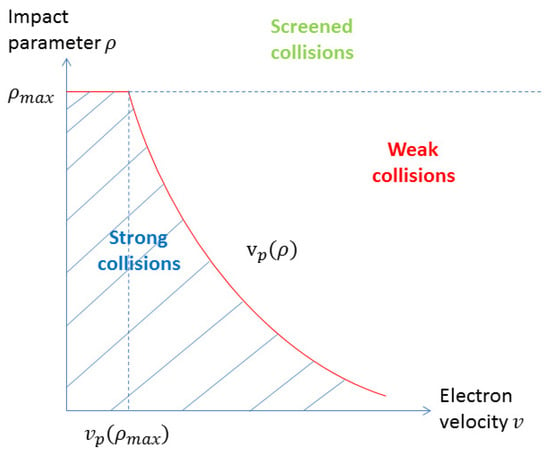
Figure 3.
Simplified schematic representation of three different collisional regimes: screened, weak and strong in the (,v) plane, being the impact parameter and v the electron velocity. represents the frontier between strong and weak collisions. It corresponds to .
- Weak collisions: or . Unitarity ensured, in the integrand.
- Strong collisions: or . Unitarity violated, in the integrand (Lorentz–Weisskopf approach).
- Screened collisions: or . No contribution to .
The diagonal element of the strong collision part is
and the minimum velocity is given by
In the following, we replace by but in Section 4.2, we use the exact non-relativistic expression for average quantities, depending on and . Assuming the Maxwell distribution for the incoming free electron
we get
Noting that
the weak-collision diagonal part is
i.e.,
and therefore the total diagonal matrix element of the collision operator reads
Under the assumption
the final Standard Theory form of the diagonal matrix element of the collision operator becomes therefore
which is the expression of Griem [36]. It is also possible to integrate first on velocity and then on impact parameter (see Appendix B).
Since most of the collisions are weak and correspond to , where is the Weisskopf radius, they are therefore the main part of the broadening. The strong collisions correspond to and their contribution to the electron broadening represents usually less than 20% [36,37].
4.2. Case of Penetrating Collisions
In low-density plasmas, the dominant contribution comes from long-range, distant collisions, for which the standard dipole approximation is not in question. For those close encounters which penetrate the wave-function extent, the interaction is softened. Indeed, as mentioned above we have, for the emitter–perturber interaction energy [17]:
where and are the emitter and perturbing electron positions respectively and for , while this would diverge in the dipole approximation. Hence for close encounters, for which penetration occurs and the dipole approximation fails, we have a smaller (softer) interaction. It can happen, if the perturber velocity is high enough, that this softening changes the collision from a strong one to a weak one. This is particularly the case with almost head-on collisions, where a divergent interaction in Standard Theory actually gives a zero result when penetration is accounted for. At larger impact parameters, Standard Theory and Penetration Standard Theory give the same (small) value. At very small , the latter gives 0, while Standard Theory diverges. These differences persist until about the relevant wave-function extent. Except for the very small impact parameter regime, these differences are important if Penetration Standard Theory stays perturbative. Otherwise, the approximation is thought to be an appropriate one for non perturbative behavior. This quantity oscillates around unity when unitarity breaks down. The relevance of penetration is then seen most clearly if the shielding length becomes small, so that a sizeable part of the impact parameter phase space is within the wave-function extent. What happens in the extreme limit where the shielding length becomes less than the wave-function extent, i.e., for high densities or high principal quantum numbers is difficult to answer in detail. However, we may expect to find the usual Stark trends reversed and large deviations from Standard Theory.
Our new expression of the collision operator including penetration (see Equation (42) is easy to compute and facilitates the study and the accounting for penetrating collisions. It is interesting to see that the function g behaves like (as in the standard theory without penetration effects) for high-enough values of the upper cutoff . Since the penetration standard theory is convergent for impact parameters as low as zero, there is no need for a minimum cutoff (even though cutoffs on v and should be introduced normally to avoid a violation of the perturbation theory).
The determination of , as in the Standard Theory the determination of , amounts to solving:
Although this may be done separately for each matrix element, yielding therefore a specific for each matrix element, we wish to keep the discussion on the same level as Standard Theory, which does not employ matrix-element dependent cutoffs. The quantity can be simplified as
where is given by Equation (34). We can also replace the function by its average over ℓ [23]:
which gives
Using the sum rule (see Ref. [66], Equation (3) p. 153):
one gets
and Equation (63) can be put in the form
We want to compare
with
and
The quantity represents the contribution of the penetrating-collision operator in the regime of strong collisions. The latter is convergent in that regime, but this does not mean that the results are correct. On the other hand, represents the way the strong collisions should be treated. If and differ significantly in that region, this means that the Penetration Standard Theory is not applicable in the strong-collision regime, although it is convergent, and that must be replaced by . We get
and
The weak-collision part is
We can also compare with the strong-collision contribution in the framework of the Standard Theory:
with
which can be put in the form
Our results can be checked using sum rules (see Appendix C). As discussed in Section 4.1, integrating on velocities first, and then on impact parameters gives the same result, but the domain has to be split into
with
The quantity is equal to
and represents the strong collisions term in the Standard Theory (see Section 4.1).
As pointed out by Alexiou [18] in the context of the interpretation of the H experiments mentioned above [62,63], Penetration Standard Theory yields larger widths for the weak-collision contribution, but a much smaller strong-collision contribution. This increases the relative proportion of the phase space that is reliably computed (weak collisions) compared to those approximated (strong collisions).
Figure 4, Figure 5 and Figure 6 represent the different schemes (transitions or channels) for the modelling of the collision operator. The first one (type I, see Figure 4) corresponds to nondiagonal terms of the operator and does not exist in the case of hydrogen; the second one (type II, see Figure 5) to interference terms and the third one (type III, see Figure 6) to diagonal terms. The first one gives a zero contribution in the case of the hydrogen atom. Figure 6, Figure 7, Figure 8 and Figure 9 display comparisons between the exact computation of and the approximate expressions (see Equation (63)) and (see Equation (68)) for different channels (type II for Figure 7 and Figure 9 and type III for Figure 8 and Figure 10). For both types, two values of the principal quantum number were chosen: (Figure 7 and Figure 8) and (Figure 9 and Figure 10). We can see that the approximate form (63) is very close to the exact results, and that the cruder approximation (68) still has a rather satisfactory accuracy. In the case of a high value of the principal quantum number, the agreement is not as good, especially for impact parameters larger than 20. Figure 11 displays the exact computation of for all channels included in (Type III). We can see that the dispersion is very important; therefore, it would probably not be relevant to calculate and average the collision operator between the two shells and . A comparison between the exact expression of and the approximate expression (see Equation (63)) in the framework of Penetration Theory for , , , as a function of is presented in Figure 12. Here also, the agreement is excellent. Figure 13 shows the ratios (see Equations (72) and (74)) and (see Equations (72) and (74)) as functions of temperature (atomic units) for . Since and differ significantly in that region (especially for very low temperatures), the Penetration Standard Theory must not be applied in the regime of strong collisions, although it is convergent, and must be replaced by . Note that the strong collisions become comparable (and even larger) to weak collisions for temperatures smaller than ≈1 eV. The variation of the ratio (see Equation (75)) as a function of temperature for the same conditions (excitation channel, maximum impact parameter, etc.) as Figure 13 is represented in Figure 14 and reveals that the strong collisions are probably largely overestimated in the Standard Theory. Figure 14 displays a simplified schematic representation of three different collisional regimes: screened, weak and strong in the (,v) plane, being the impact parameter and v the electron velocity.
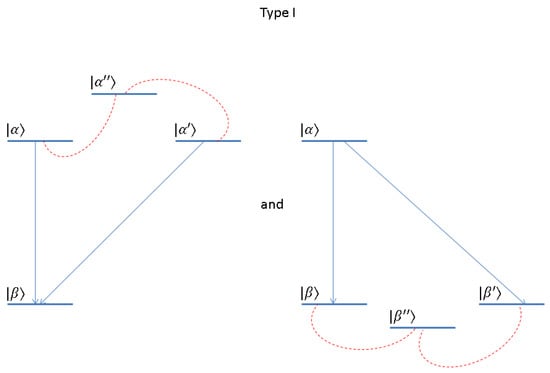
Figure 4.
Atomic schemes corresponding to nondiagonal terms of the collision operator (type I).
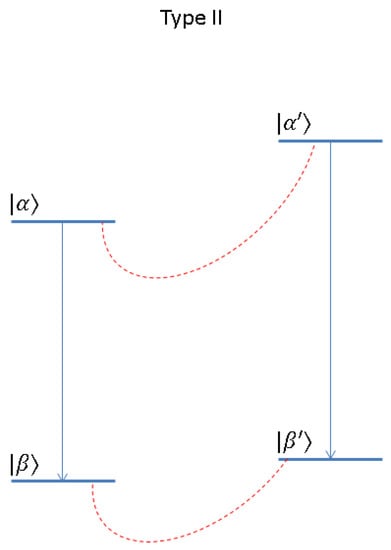
Figure 5.
Atomic schemes corresponding to interference terms of the collision operator (type II).
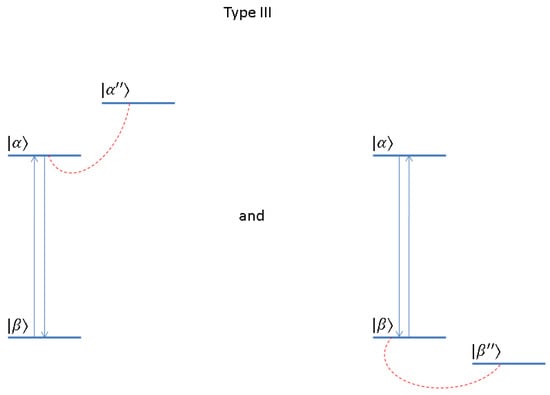
Figure 6.
Atomic schemes corresponding to diagonal terms of the collision operator (type III).
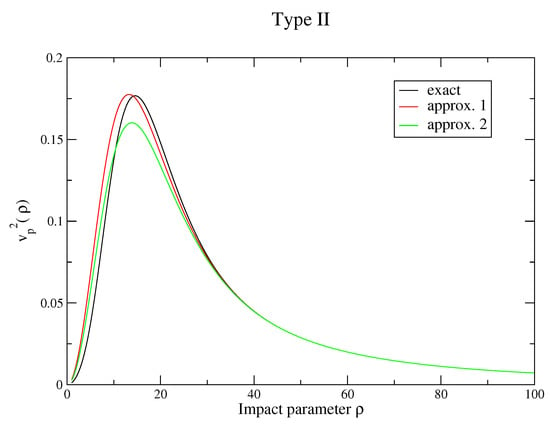
Figure 7.
Comparison between the exact computation of and the approximate expressions (see Equation (63)) and (see Equation (68)) for , , , , and , , , , , and (Type II).
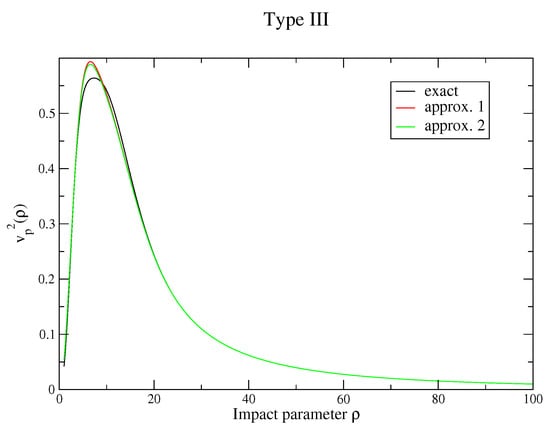
Figure 8.
Comparison between the exact computation of and the approximate expressions (see Equation (63)) and (see Equation (68)) for , , , , and , , , , , and (Type III).
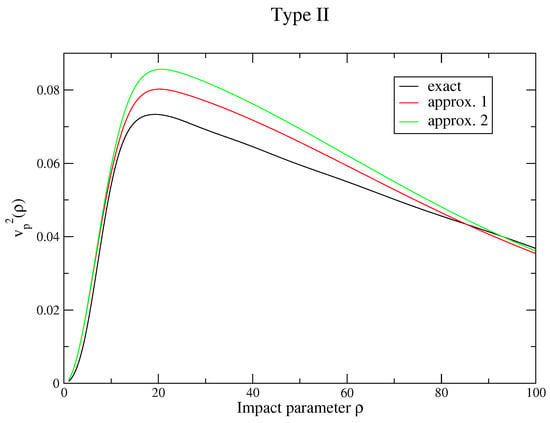
Figure 9.
Comparison between the exact computation of and the approximate expressions (see Equation (63)) and (see Equation (68) for , , , , and , , , , , and (Type II).
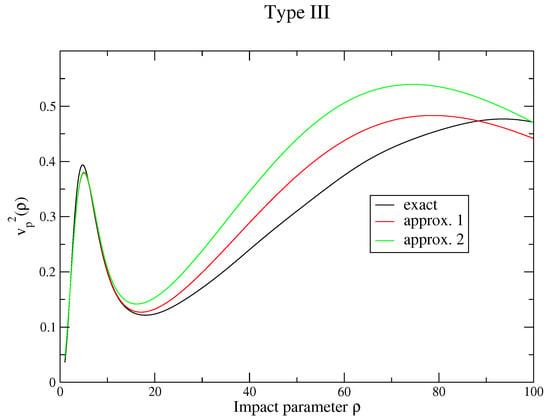
Figure 10.
Comparison between the exact computation of and the approximate expressions (see Equation (63)) and (see Equation (68)) for , , , , and , , , , , and (Type III).
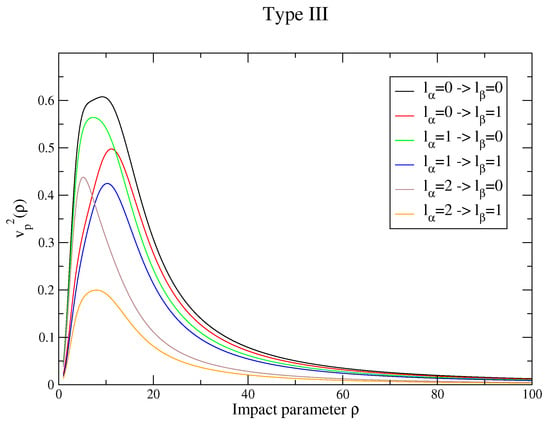
Figure 11.
Exact computation of for all channels included in (Type III).
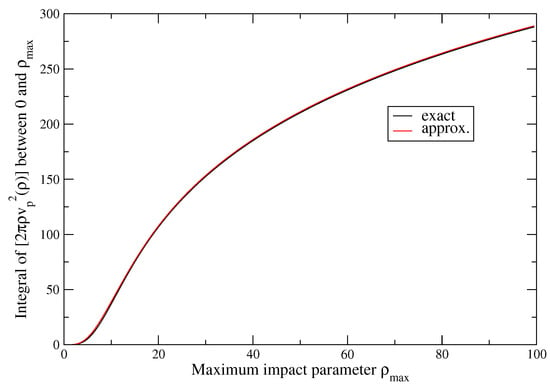
Figure 12.
Comparison between exact expression of and the approximate expression (see Equation (63)) in the framework of Penetration Theory for , , , , , , , and as a function of .
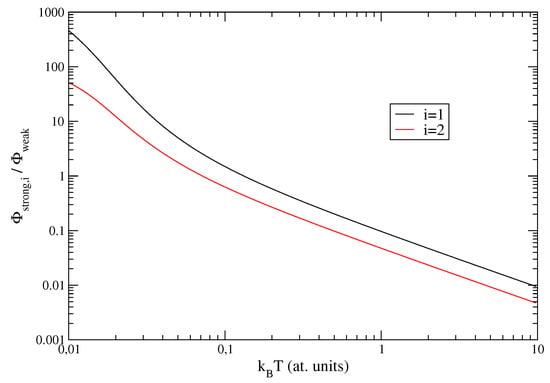
Figure 13.
Ratio (see Equations (72) and (74)) and (see Equations (73) and (74)) as functions of temperature (atomic units) for = 3, = 2, = 2, = 1, and .
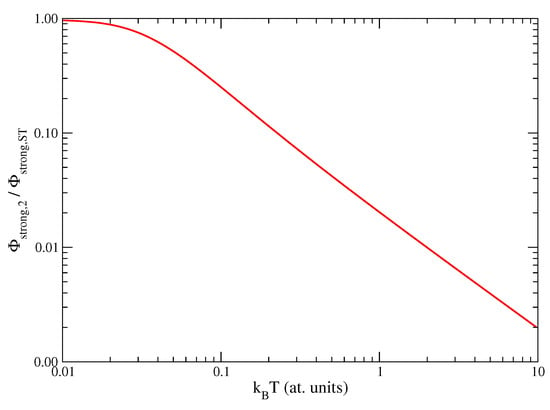
Figure 14.
Ratio (see Equation (75)) as a function of temperature (atomic units) for = 3, = 2, = 2, = 1, and .
When the temperature is high, unitarity-violating collisions are not significant and the Standard Theory “strong collision term” is misrepresented, as it arises from very weak, penetrating collisions. The qualitative behavior of Penetration Standard Theory is to be expected: at very low densities, the phase space inside the wave-function extent is unable to compete with the large-impact-parameter phase space, hence the relative importance must tend to 0 as the density decreases. Similarly, for very high densities, the whole phase space tends to be completely inside the wave-function extent, and this means a decreasing relative strong contribution, as even slow collisions are softened more and more by penetration. Hence a maximum is expected for Penetration Standard Theory. Generally, the weak collision contribution to Penetration Standard Theory is larger than the corresponding Standard Theory contribution, because of the larger Penetration Standard Theory weak collision phase space, while the strong collision contribution to Penetration Standard Theory is much smaller than the corresponding strong collision contribution to Standard Theory. This is why the relative strong collision width is smaller in the Penetration Standard Theory, which in turn means increased confidence in the final result.
In this work, we have considered that perturbing electrons pass the radiating atom as free particles. In reality, they move in the dipole potential (hydrogen atom possesses permanent electric dipole moment). Oks suggested to overcome that assumption [65]. He also proposed a more accurate definition of the so-called Weisskopf radius, different from of one used by Griem. This might be important because the choices of the Weisskopf radius and the strong collision constant are interrelated. Oks found that the latter refinements increase the electron broadening, especially for warm dense plasmas.
5. Conclusions
A semi-classical model for the electron broadening operator including the effect of penetrating collisions on isolated lines of hydrogen, i.e., collisions in which the incoming electron enters the extent of bound-electron wave-functions, was developed by Alexiou and Poquérusse. The corresponding formalism is rather complex and involves recursive calculations and Bessel and Bickley–Naylor functions. We derived an approximate expression for the collision operator, which is very simple, easy to compute, and accurate. Such a formula should also help to improve the understanding of strong collisions and the limits of standard theory. However, one has to keep in mind the fact that, in the Penetration Standard Theory, the collision operator is convergent whatever the value of the maximum impact parameter, even when penetration theory is not valid anymore. Therefore, we discussed the problem of strong collisions when penetration effects are taken into account and found that applying the penetration theory even for very low values of the impact parameter (i.e., when the density is low and/or the temperature is high) may lead to overestimate the contribution of strong collisions to the line broadening.
Author Contributions
Both authors contributed equally to the work presented here. All authors have read and agreed to the published version of the manuscript.
Funding
This research received no external funding.
Acknowledgments
This work is dedicated to the memory of Hans Griem.
Conflicts of Interest
The authors declare no conflict of interest.
Appendix A. The Interaction Picture: From the General Case to Hydrogen in the Standard Theory
Appendix A.1. Collision Operator in the Interaction Picture for Neutral Emitter
The electron collision operator can be developed with respect to the interaction in a perturbation series:
where, in the interaction picture:
being the Hamiltonian. Under the straight-path assumption (valid only for a neutral emitter), the perturbation produced by the collision with an electron has the form
where is the radius vector of an atomic electron. In Equation (A1), the first order does not contribute, because the average of over all directions of the vectors and is zero. For the second order, we have [67,68]:
The second and third terms of expression (A1) can be calculated using:
where represents the difference between the energies of states i and j. By introducing the dimensionless variables
Equation (A5) becomes
where
The summation over is restricted to the states of the level a and neglecting the perturbation due to all the other levels. The values are not zero only for neighboring Stark components . At , and at , . Let us denote the corresponding integrals , and , . The real part can be expressed in terms of modified Bessel functions as
where and are Bessel functions of the second kind [69] (sometimes called Basset functions or Macdonald functions). One must, in general, compute from a dispersion relation, making use of the fact that A and B are real and imaginary parts of the same complex function (where indicates Cauchy principal value [52,70]):
Their asymptotic behavior for large yields
and for small :
Appendix A.2. Case of Hydrogen
For hydrogen, the exponential functions disappear in Equation (A5) because and . One has therefore (as in the previous case): and .
Appendix B. Strong Collisions in the Standard Theory: Integrating First on Velocity and Then on Impact Parameter
It is worth mentioning that it is possible to interchange the integrations, i.e., to integrate first on velocity v, and then on impact parameter . For the strong-collision part, this means
where is given by Equation (49). The integration over velocities gives
and thus
As concerns the weak-collision part
we have
and thus
which yields
which is exactly Equation (58). Making the substitution
we get
and
which is exactly Equation (60).
Appendix C. Checking the Matrix Elements Using Sum Rules
In order to check the calculations, it is useful to resort to sum rules.
- For instance, a simplification of the expression giving the total strength between shells n and has been obtained by McLean [71,72,73] using recursion relations between Gauss hypergeometric functions:where . One should havewhere is given by Equation (5).
- Another interesting check is provided by the average collision operator [74,75]Definingone has
References
- Banaz, O. Spectral Line Broadening of He I and He-like Ions in Dense Plasmas. Ph.D. Thesis, Rostock University, Rostock, Germany, 2007. [Google Scholar]
- Baranger, M. Problem of Overlapping Lines in the Theory of Pressure Broadening. Phys. Rev. 1958, 111, 494–504. [Google Scholar] [CrossRef]
- Kolb, A.C.; Griem, H.R. Theory of Line Broadening in Multiplet Spectra. Phys. Rev. 1958, 111, 514–521. [Google Scholar] [CrossRef]
- Anderson, P.W. Pressure Broadening in the Microwave and Infra-Red Regions. Phys. Rev. 1949, 76, 647–661. [Google Scholar] [CrossRef]
- Hitzschke, L.; Röpke, G.; Seifert, T.; Zimmermann, R. Diagnostics of a laser-induced dense plasma by hydrogen-like carbon spectra. J. Phys. B At. Mol. Opt. Phys. 1986, 19, 2443–3000. [Google Scholar]
- Günter, S. Optische Eigenschaften dichter Plasmen. Habilitation Thesis, Rostock University, Rostock, Germany, 1995. [Google Scholar]
- Iglesias, C.A. Reformulation of plasma spectral line broadening with computer. High Energy Density Phys. 2019, 33, 1–6. [Google Scholar] [CrossRef]
- Stamm, R.; Voslamber, D. On the role of ion dynamics in the stark broadening of hydrogen lines. J. Quant. Spectros. Radiat. Transfer. 1979, 22, 599–609. [Google Scholar] [CrossRef]
- Bedida, N.; Meftah, M.T.; Difallah, M. Path Integral Formalism for Line Broadening in Plasmas: Lyman-α case. Contrib. Plasma Phys. 2014, 54, 783–790. [Google Scholar] [CrossRef]
- Feynman, R.H.; Hibbs, A.R. Quantum Mechanics and Path Integrals; McGraw-Hill: New York, NY, USA, 1965. [Google Scholar]
- Sahal-Bréchot, S. Impact Theory of the Broadening and Shift of Spectral Lines due to Electrons and Ions in a Plasma. Astron. Astrophys. 1969, 1, 91–123. [Google Scholar]
- Sahal-Bréchot, S. Impact Theory of the Broadening and Shift of Spectral Lines due to Electrons and Ions in a Plasma (Continued). Astron. Astrophys. 1969, 2, 322–354. [Google Scholar]
- Deutsch, C.; Herman, L.; Drawin, H.W. Electron-impact broadening of overlapping He I lines in plasmas. Phys. Rev. 1969, 178, 261–270. [Google Scholar] [CrossRef]
- Deutsch, C.; Herman, L.; Drawin, H.W. Asymptotic behavior of the generalized width and shift functions in the electron-impact broadening theory of neutral spectral lines in plasmas. Phys. Rev. 1969, 186, 204–209. [Google Scholar] [CrossRef]
- Alexiou, S. Implementation of the Frequency Separation Technique. High Energy Density Phys. 2013, 9, 375–384. [Google Scholar] [CrossRef]
- Griem, H.R. Principles of Plasma Spectroscopy; Cambridge University Press: Cambridge, UK, 1997. [Google Scholar]
- Alexiou, S.; Lee, R.W. Electron line broadening in plasmas: Resolution of the quantum vs. semiclassical calculations puzzle. In Spectral Line Shapes, Proceedings of the AIP Conference, Melville, NY, USA, 11–14 July 2001; Seidel, J., Ed.; AIP: College Park, MD, USA, 2001; Volume 599, p. 135. [Google Scholar]
- Alexiou, S.; Poquérusse, A. Standard line broadening impact theory for hydrogen including penetrating collisions. Phys. Rev. E 2005, 72, 046404. [Google Scholar] [CrossRef] [PubMed]
- Alexiou, S.; Lee, R.W. Semiclassical calculations of line broadening in plasmas: Comparison with quantal results. J. Quant. Spectrosc. Radiat. Transf. 2006, 99, 10–20. [Google Scholar] [CrossRef]
- Poquérusse, A.; Alexiou, S. Penetrating standard line broadening impact theory for hydrogen-like ions. J. Quant. Spectrosc. Radiat. Transf. 2006, 99, 493–498. [Google Scholar] [CrossRef]
- Alexiou, S. H-like ions with penetrating collision. J. Phys. Conf. Ser. 2017, 810, 012022. [Google Scholar] [CrossRef]
- Alexiou, S. Enhancement of line broadening in plasmas by penetrating collisions for hydrogenlike lines. High Energy Density Phys. 2017, 23, 188–194. [Google Scholar] [CrossRef]
- Pain, J.-C.; Gilleron, F. Modeling penetrating collisions in the standard line broadening impact theory for hydrogen. High Energy Density Phys. 2019, 30, 52–59. [Google Scholar] [CrossRef]
- Griem, H.R.; Ralchenko, Y.V. Stark broadening of the B III 2s-2p lines. Phys. Rev. E 1997, 56, 7186–7192. [Google Scholar] [CrossRef]
- Griem, H.R.; Ralchenko, Y.V. Electron collisional broadening of isolated lines from multiply ionized atoms. J. Quant. Spectrosc. Radiat. Transfer 2000, 65, 287–296. [Google Scholar] [CrossRef]
- Hey, J.D.; Griem, H.R. Central structure of low-n Balmer lines in dense plasmas. Phys. Rev. A 1975, 12, 169–185. [Google Scholar] [CrossRef]
- Voslamber, D. Upper-lower state interference term in Stark-broadening theory: Comment on a paper by J. D. Hey and H. R. Griem. Phys. Rev. A 1976, 14, 1903–1905. [Google Scholar] [CrossRef]
- Griem, H.R.; Hey, J.D. Reply to “Upper-lower state interference term in Stark broadening”. Phys. Rev. A 1976, 14, 1906. [Google Scholar] [CrossRef]
- Gigosos, M.A.; González, M.Á.; Talin, B.; Calisti, A. Exact expression of the impact broadening operator for hydrogen Stark broadening. Astron. Astrophys. 2007, 466, 1189–1196. [Google Scholar] [CrossRef][Green Version]
- Galtier, E.; Rosmej, F.B.; Calisti, A.; Talin, B.; Mossé, C.; Ferri, S.; Lisitsa, V.S. Interference effects and Stark broadening in XUV intrashell transitions in aluminum under conditions of intense XUV free-electron-laser irradiation. Phys. Rev. A 2013, 87, 033424. [Google Scholar] [CrossRef]
- Gordon, W. Zur Berechnung der Matrizen beim Wasserstoffatom. Ann. Phys. 1929, 2, 1031–1056. [Google Scholar] [CrossRef]
- Bethe, H.A.; Salpeter, E.E. Quantum Mechanics of One- and Two-Electron Atoms; Springer: Berlin/Heidelberg, Germany, 1957. [Google Scholar]
- Tarasov, V.F.W. Gordons integral (1929) and its representations by means of Appells functions F2, F1 and F3. J. Math. Phys. 2003, 44, 1449–1452. [Google Scholar] [CrossRef]
- Lewis, M. Stark broadening of spectral lines by high-velocity charged particles. Phys. Rev. 1960, 121, 501–505. [Google Scholar] [CrossRef]
- Smith, E.W. Electron Correlations in Plasma Line Broadening. Phys. Rev. 1968, 166, 102–113. [Google Scholar] [CrossRef]
- Griem, H.R.; Kolb, A.C.; Chen, K.Y. Stark Broadening of Hydrogen Lines in a Plasma. Phys. Rev. 1959, 116, 4–16. [Google Scholar] [CrossRef]
- Griem, H.R.; Baranger, M.; Kolb, A.C.; Oertel, G. Stark Broadening of Neutral Helium Lines in a Plasma. Phys. Rev. 1962, 125, 177–195. [Google Scholar] [CrossRef]
- Griem, H.R.; Shen, K.Y. Stark Broadening of Hydrogenic Ion Lines in a Plasma. Phys. Rev. 1961, 122, 1490–1496. [Google Scholar] [CrossRef]
- Kepple, P.C. Improved Stark-Profile Calculations for the He II Lines at 256, 304, 1085, 1216, 1640, 3203, and 4686 Å. Phys. Rev. A 1972, 6, 1–9. [Google Scholar] [CrossRef]
- Baranger, M. Simplified Quantum-Mechanical Theory of Pressure Broadening. Phys. Rev. 1958, 111, 481–493. [Google Scholar] [CrossRef]
- Nguyen-Hoe, H.; Drawin, W.; Herman, L. Asymetrie du profil de la raie Lyα de l’atome hydrogène. J. Quant. Spectrosc. Radiat. Transf. 1964, 4, 847–856. [Google Scholar] [CrossRef]
- Deutsch, C.; Klarsfeld, S. Quadrupole contributions to the electron broadening of overlapping neutral-atom lines in a plasma. Phys. Rev. A 1973, 7, 2081–2086. [Google Scholar] [CrossRef]
- Gomez, T.A.; Nagayama, T.; Kilcrease, M.H.; Winget, D.E. Effect of higher multipole moments on the Stark line shape. Phys. Rev. A 2016, 94, 022501. [Google Scholar] [CrossRef]
- Inglis, D.R.; Teller, E. Ionic depression of series limit in one-electron spectra. Astrophys. J. 1939, 90, 439–448. [Google Scholar] [CrossRef]
- Chappell, W.R.; Cooper, J.; Smith, E.W. Electron correlations in stark broadening. J. Quant. Spectrosc. Radiat. Transfer 1969, 9, 149–151. [Google Scholar] [CrossRef]
- Bacon, M.E.; Edwards, D.F. Effect of Strong Collisions on the Hα profile. Phys. Rev. 1968, 170, 125–127. [Google Scholar] [CrossRef]
- Griem, H.R.; Blaha, M.; Kepple, P.C. Stark-profile calculations for Lyman-series lines of one-electron ions in dense plasmas. Phys. Rev. A 1979, 19, 2421–2432. [Google Scholar] [CrossRef]
- Alexiou, S. Scaling of hydrogen electron Stark widths at high densities and the Inglis-Teller limit. High Energy Density Phys. 2009, 5, 68–73. [Google Scholar] [CrossRef]
- Günter, S. Contributions of strong collisions in the theory of spectral lines. Phys. Rev. E 1993, 48, 500–505. [Google Scholar] [CrossRef]
- Günter, S. Computational Investigation of Radiation from Dense Plasmas. Ph.D. Thesis, Universität Rostock, Rostock, Germany, 1990. [Google Scholar]
- Günter, S.; Röpke, G.; Hitzschke, L. Hydrogen spectral lines with the inclusion of dense-plasma effects. Phys. Rev. A 1991, 44, 6834–6844. [Google Scholar] [CrossRef]
- Griem, H.R. Spectral Line Broadening by Plasmas; Academic: New York, NY, USA, 1974. [Google Scholar]
- Griem, H.R. Shifts of hydrogen lines from electron collisions in dense plasmas. Phys. Rev. A 1983, 28, 1596–1601. [Google Scholar] [CrossRef]
- Iglesias, C.A.; Boercker, D.B.; Lee, R.W. Comment on “Shifts of hydrogen lines from electron collisions in dense plasmas. Phys. Rev. A 1985, 32, 1906–1907. [Google Scholar] [CrossRef]
- Griem, H.R. Shifts of hydrogen and ionized-helium lines from Δn = 0 interactions with electrons in dense plasmas. Phys. Rev. A 1988, 38, 2943–2952. [Google Scholar] [CrossRef]
- Voslamber, D. Unified Model for Stark Broadening. Z. Naturforschung A 1969, 24, 1458–1472. [Google Scholar]
- Vidal, R.; Cooper, J.; Smith, E.W. Hydrogen Stark broadening calculations with the unified classical path theory. J. Quant. Spectrosc. Radiat. Transf. 1970, 10, 1011–1063. [Google Scholar] [CrossRef]
- Baranger, M. General Impact Theory of Pressure Broadening. Phys. Rev. 1959, 112, 855–865. [Google Scholar] [CrossRef]
- Unnikrishnan, K.; Callaway, J. Shift and width of the Lyman-α line of neutral hydrogen due to electron collisions. Phys. Rev. A 1991, 43, 3619–3623. [Google Scholar] [CrossRef] [PubMed]
- Griem, H.R. Plasma Spectroscopy; McGraw-Hill: New York, NY, USA, 1964. [Google Scholar]
- Greene, R.L. Inclusion of ion dynamics in the unified classical path theory of Stark broadening. Phys. Rev. A 1979, 19, 2002–2008. [Google Scholar] [CrossRef]
- Böddeker, S.; Günter, S.; Könies, A.; Hitzschke, L.; Kunze, H.J. Shift and width of the Hα line of hydrogen in dense plasmas. Phys. Rev. 1993, 47, 2785–2791. [Google Scholar]
- Büscher, S.; Wrubel, T.H.; Ferri, S.; Kunze, H.-J. The Stark width and shift of the hydrogen Hα line. J. Phys. B At. Mol. Opt. Phys. 2002, 35, 2889–2897. [Google Scholar] [CrossRef]
- Kepple, P.; Griem, H.R. Improved Stark profiles calculations for the hydrogen lines Hα, Hβ, Hγ and Hδ. Phys. Rev. 1968, 173, 317–325. [Google Scholar] [CrossRef]
- Oks, E. Refinement of the semiclassical theory of the Stark broadening of hydrogen spectral lines in plasmas. J. Quant. Spectrosc. Radiat. Transfer 2015, 152, 74–83. [Google Scholar] [CrossRef]
- Varshalovich, D.A.; Moskalev, A.N.; Khersonskii, V.K. Quantum Theory of Angular Momentum; World Scientific: Singapore, 1988. [Google Scholar]
- Sobel’Man, I.I. Introduction to the Theory of Atomic Spectra, 1st ed.; International Series of Monographs in Natural Philosophy; Pergamon Press: New York, NY, USA, 1972. [Google Scholar]
- Sobel’Man, I.I.; Vainshtein, L.A.; Yukov, E.A. Excitation of Atoms and Broadening of Spectral Lines, 2nd ed.; Springer Series on Atoms and Plasmas; Springer: Berlin/Heidelberg, Germany, 1995. [Google Scholar]
- Abramowitz, M.; Stegun, I.A. Handbook of Mathematical Functions; Applied Mathematics Series 55; U. S. Government Printing Office: Washington, DC, USA, 1964.
- Cooper, J.; Oertel, G.K. Electron-Impact Broadening of Isolated Lines of Neutral Atoms in a Plasma. I. Phys. Rev. 1969, 180, 286–298. [Google Scholar] [CrossRef]
- McLean, L. General expression for the intensity of hydrogen lines. Phil. Mag. 1934, 18, 845–874. [Google Scholar] [CrossRef]
- Watson, J.K. A formula for line strengths of hydrogenic atoms. J. Phys. B At. Mol. Opt. Phys. 2006, 39, L291–L297. [Google Scholar] [CrossRef]
- Hey, J.D. The McLean-Watson line strength formula and its implementation. J. Phys. B At. Mol. Opt. Phys. 2009, 42, 125701. [Google Scholar] [CrossRef]
- Casini, R.; Landi Degl’Innocenti, E.L. Algebraic proof of a sum rule occurring in Stark broadening of hydrogen lines. J. Math. Phys. 1995, 38, 3435–3445. [Google Scholar] [CrossRef][Green Version]
- Gilleron, F.; Pain, J.-C. Statistical modeling of line shapes of a hydrogenic atom broadened by the Stark effect. J. Phys. B At. Mol. Opt. Phys. 2019, 52, 245001. [Google Scholar] [CrossRef]
| 1. | the formula has been symmetrized to account for . |
| 2. | The is a typo in the caption of Figure 6 in Ref. [23]: the end of the last sentence should read “ = 3, = 2 and = 1.” (but the legend is correct). |
© 2020 by the authors. Licensee MDPI, Basel, Switzerland. This article is an open access article distributed under the terms and conditions of the Creative Commons Attribution (CC BY) license (http://creativecommons.org/licenses/by/4.0/).
